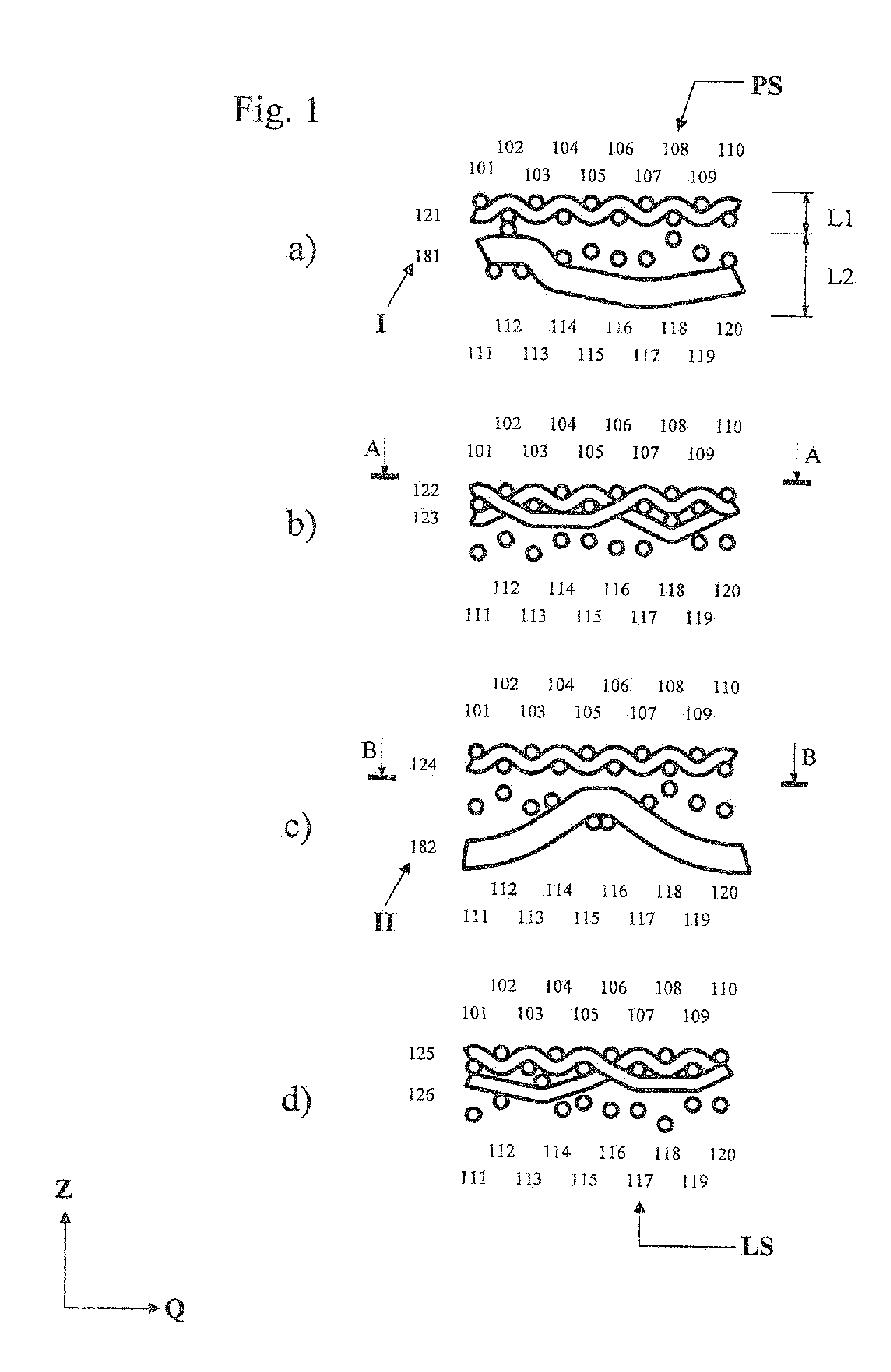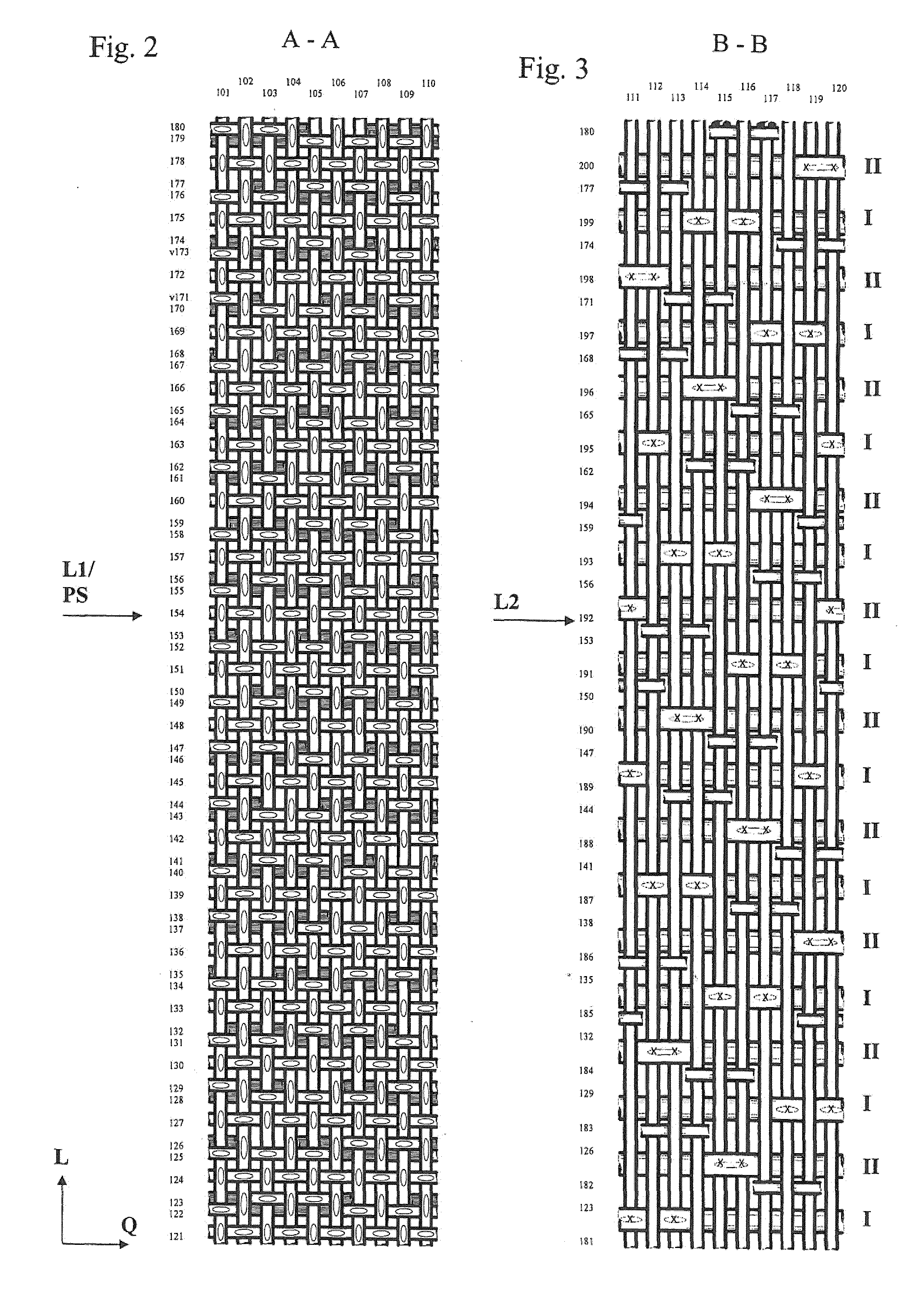Papermaking machine wire, the running side of which has cross threads with different lengths
a technology of cross threads and papermaking machines, applied in the field of papermaking machine wires, can solve the problems of uneven running side, material loss, and negative affecting both the running screen and paper quality,
- Summary
- Abstract
- Description
- Claims
- Application Information
AI Technical Summary
Benefits of technology
Problems solved by technology
Method used
Image
Examples
first embodiment
[0094]FIGS. 1 to 4 show a paper machine screen / sheet forming screen (below referred to as “screen”) formed as a multi-layer fabric, according to the invention.
[0095]As can be seen, for example, in FIGS. 1a) to 1d), the screen is formed as a multi-layer fabric with an upper fabric layer L1 and a lower fabric layer L2 that are connected to each other by means of binding threads (see transverse thread 123 in FIG. 1b) as well as the transverse thread 126 in FIG. 1d)). The paper side PS of the screen is formed by the upper fabric layer L1, whereas the running side LS of the screen is formed by the lower fabric layer L2.
[0096]The lower fabric layer L2 is formed by a plurality of uniformly structured lower weave repeats (and consists, for example, of those) each of which containing longitudinal threads 111-120 extending in the lower fabric layer L2 and lower transverse threads 181-200 (e.g. the respective repeat consists of said threads) that extend exclusively in the lower fabric layer L2...
second embodiment
[0134]The lower fabric layer L2′ of the screen is formed by (and, e.g. consists of) a plurality of uniformly structured lower weave repeats, each of which comprising longitudinal threads 501-508 extending in the lower fabric layer L2′ and lower transverse threads 521-536 (e.g. the respective repeat consists of the mentioned threads), extending exclusively in the lower fabric layer L2′ and being interwoven with the longitudinal threads 501-508 extending in the lower fabric layer.
[0135]As shown in FIG. 5, the longitudinal threads extending in the lower fabric layer can be formed, e.g. as lower longitudinal threads 501-508 extending exclusively in the lower fabric layer L2′ and being, for example, interwoven with the lower transverse threads 521-538 thereby completely forming the lower weave. In the following, reference is thus made to lower longitudinal threads even though the longitudinal threads 501-508 extending in the lower fabric layer may be configured differently.
[0136]Analogo...
third embodiment
[0155]The lower fabric layer L2″ of the screen is formed by (and, e.g. consists of) a plurality of uniformly structured lower weave repeats, each of which comprising longitudinal threads 601-612 extending in the lower fabric layer L2″ and lower transverse threads 621-644 (e.g. the respective repeat consists of the mentioned threads), extending exclusively in the lower fabric layer L2″ and being interwoven with the longitudinal threads 601-612 extending in the lower fabric layer.
[0156]As shown in FIG. 6, the longitudinal threads extending in the lower fabric layer can be formed, e.g. as lower longitudinal threads 601-612 extending exclusively in the lower fabric layer L2″ and being, for example, interwoven with the lower transverse threads 621-644 thereby completely forming the lower weave. In the following, reference is thus made to lower longitudinal threads even though the longitudinal threads 621-644 extending in the lower fabric layer may be configured differently.
[0157]The low...
PUM
 Login to View More
Login to View More Abstract
Description
Claims
Application Information
 Login to View More
Login to View More - R&D
- Intellectual Property
- Life Sciences
- Materials
- Tech Scout
- Unparalleled Data Quality
- Higher Quality Content
- 60% Fewer Hallucinations
Browse by: Latest US Patents, China's latest patents, Technical Efficacy Thesaurus, Application Domain, Technology Topic, Popular Technical Reports.
© 2025 PatSnap. All rights reserved.Legal|Privacy policy|Modern Slavery Act Transparency Statement|Sitemap|About US| Contact US: help@patsnap.com



